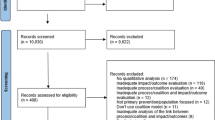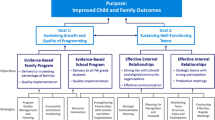Abstract
This study examines how aspects of coalition functioning predict a coalition’s ability to promote high-quality implementation of evidence-based programs (EBPs). The study involved 62 Communities That Care (CTC) coalitions in Pennsylvania measured annually from 2003 to 2007. Findings indicate that the communities with higher levels of poverty and longer existing coalitions are related to lower support for high-quality EBP implementation. Several aspects of coalition functioning—including higher levels of funding; leadership strength; board efficiency; strong internal and external relationships; and fidelity to the CTC model—significantly predicted support for high-quality EBP implementation. Earlier measurements of coalition functioning (2003–2004 and 2005–2006) predicted EBP implementation (2007) more strongly than concurrent coalition assessments (2007). The discussion focuses on how coalitions and technical assistance providers can improve coalition support for the implementation of EBPs.
Similar content being viewed by others
References
Arthur, M. W., & Blitz, C. (2000). Bridging the gap between science and practice in drug abuse prevention through needs assessment and strategic community planning. Journal of Community Psychology, 28, 241–255.
Brown, E. C., Hawkins, D. J., Arthur, M. W., Briney, J. S., & Abbott, R. D. (2007). Effects of Communities That Care on prevention services systems: Findings from the Community Youth Development Study at 1.5 years. Prevention Science, 8, 180–191.
Bryson, J. M. (1995). Strategic planning for profit and nonprofit organizations: A guide to strengthening and sustaining organizational achievement. San Francisco: Jossey-Bass.
Butterfoss, F. D. (2008). Coalitions and partnerships in community health. San Francisco: Jossey-Bass.
Butterfoss, F. D., Goodman, R. M., & Wandersman, A. (1996). Community coalitions for prevention and health promotion: Factors predicting satisfaction, participation, and planning. Health Education Quarterly, 23, 65–79.
Carlson, M. (2002). Winning grants: Step by step. San Francisco: Jossey-Bass.
Concato, J., Shah, N., & Horwitz, R. I. (2000). Randomized, controlled trials, observational studies, and the hierarchy of research designs. New England Journal of Medicine, 342, 1887–1892.
Diamond, J. (2005). Guns, germs, and steel: The fates of human societies. New York: Norton.
Domitrovich, C. E., & Greenberg, M. T. (2000). The study of implementation: Current findings from effective programs that prevent mental disorders in school-aged children. Journal of Educational and Psychological Consultation, 11, 193–221.
Durlak, J. A., & DuPre, E. P. (2008). Implementation matters: A review of research on the influence of implementation on program outcomes and the factors affecting implementation. American Journal of Community Psychology, 41, 327–350.
Fagan, A. A., Hanson, K., Hawkins, J. D., & Arthur, M. W. (2008). Bridging science to practice: Achieving prevention program implementation fidelity in the Community Youth Development Study. American Journal of Community Psychology, 41, 235–249.
Feinberg, M. E., Greenberg, M. T., Osgood, D. W., Anderson, A., & Babinski, L. (2002). The effects of training community leaders in prevention science: Communities That Care in Pennsylvania. Evaluation and Program Planning, 25, 245–259.
Feinberg, M. E., Greenberg, M. T., & Osgood, D. W. (2004). Readiness, functioning, and perceived effectiveness in community prevention coalitions: A study of Communities That Care. American Journal of Community Psychology, 33, 163–176.
Feinberg, M. E., Chilenski, S. M., Greenberg, M. T., Spoth, R. L., & Redmond, C. (2007a). Community and team member factors that influence the operations phase of local prevention teams: The PROSPER project. Prevention Science, 8, 214–226.
Feinberg, M. E., Greenberg, M. T., Osgood, D. W., Sartorius, J., & Bontempo, D. (2007b). Effects of the Communities That Care model in Pennsylvania on youth risk and problem behaviors. Prevention Science, 8, 261–270.
Feinberg, M. E., Bontempo, D., & Greenberg, M. T. (2008a). Predictors and level of sustainability of community prevention coalitions. American Journal of Preventive Medicine, 34, 495–501.
Feinberg, M. E., Gomez, B., Puddy, R. W., & Greenberg, M. T. (2008b). Evaluation and community prevention coalitions: Validation of an integrated web-based/technical assistance consultant model. Health Education and Behavior, 35, 9–21.
Feinberg, M. E., Ridenour, T. A., & Greenberg, M. T. (2008c). The longitudinal effect of technical assistance dosage on the functioning of Communities That Care prevention boards in Pennsylvania. Journal of Primary Prevention, 29, 145–165.
Feinberg, M. E., Jones, D., Greenberg, M. T., Osgood, D. W., & Bontempo, D. (2009). Effects of the Communities That Care model in Pennsylvania on change in adolescent risk and problem behaviors. Prevention Science. doi:10.1007/s11121-009-0161-x.
Fixsen, D. L., Naoom, S. F., Blase, K. A., Friedman, R. M., & Wallace, F. (2005). Implementation research: A synthesis of the literature. Tampa: University of South Florida.
Foster-Fishman, P. G., Berkowitz, S. L., Lounsbury, D. W., Jacobson, S., & Allen, N. A. (2001). Building collaborative capacity in community coalitions: A review and integrative framework. American Journal of Community Psychology, 29, 241–261.
Gentry, M. E. (1987). Coalition formation and processes. Social Work with Groups, 10, 39–54.
Giamartino, G. A., & Wandersman, A. (1983). Organizational climate correlates of viable urban block organizations. American Journal of Community Psychology, 11, 529–541.
Gomez, B., Greenberg, M. T., & Feinberg, M. E. (2005). Sustainability of community coalitions: An evaluation of Communities That Care. Prevention Science, 6, 199–202.
Gottfredson, D. C., & Gottfredson, G. D. (2002). Quality of school-based prevention programs: Results from a national survey. Journal of Research in Crime and Delinquency, 39, 3–35.
Greenberg, M. T., Feinberg, M. E., Meyer-Chilenski, S., Spoth, R. L., & Redmond, C. (2007). Community and team member factors that influence the early phase functioning of community prevention teams: The PROSPER project. Journal of Primary Prevention, 28, 485–504.
Hallfors, D., & Godette, D. (2002). Will the ‘principles of effectiveness’ improve prevention practice? Early findings from a diffusion study. Health Education Research, 17, 461–470.
Harachi, T. W., Ayers, C. D., Hawkins, D. J., Catalano, R. F., & Cushing, J. (1996). Empowering communities to prevent adolescent substance abuse: Process evaluation results from a risk- and protective-based community mobilization effort. Journal of Primary Prevention, 16, 233–254.
Hawkins, J. D., & Catalano, R. F. (1992). Communities That Care: Action for drug abuse prevention. San Francisco: Jossey-Bass.
Hawkins, J. D., & Catalano, R. F. (2005). Investing in your community’s youth: An introduction to the Communities That Care system. Rockville, MD: Substance Abuse and Mental Health Services Administration.
Hawkins, J. D., Catalano, R. F., & Arthur, M. W. (2002). Promoting science-based prevention in communities. Addictive Behaviors, 27, 951–976.
Hawkins, J. D., Brown, E. C., Oesterle, S., Arthur, M. W., Abbott, R. D., & Catalano, R. F. (2008). Early effects of Communities That Care on targeted risks and initiation of delinquent behavior and substance use. Journal of Adolescent Health, 43, 15–22.
Hawkins, J. D., Oesterle, S., Brown, E. C., Arthur, M. W., Abbott, R. D., Fagan, A. A., et al. (2009). Results of a type 2 translational research trial to prevent adolescent drug use and delinquency: A test of Communities That Care. Archives of Pediatric and Adolescent Medicine, 163, 789–798.
Jasuja, G. K., Chou, C.-P., Bernstein, K., Wang, E., McClure, M., & Pentz, M. A. (2005). Using structural characteristics of community coalitions to predict progress in adopting evidence-based prevention programs. Evaluation and Program Planning, 28, 173–184.
Kegler, M. C., & Wyatt, V. H. (2003). A multiple case study of neighborhood partnerships for positive youth development. American Journal of Health Behavior, 27, 156–169.
Kegler, M. C., Steckler, A., McLeroy, K., & Malek, S. H. (1998). Factors that contribute to effective community health promotion coalitions: A study of ten Project ASSIST coalitions in North Carolina. Health Education and Behavior, 25, 338–353.
Koen, C. (1999). The case for longitudinal survey research in social science analysis in South Africa. African Sociological Review, 3, 152–167.
Riggs, N. R., Nakawatase, M., & Pentz, M. A. (2008). Promoting community coalition functioning: Effects of Project STEP. Prevention Science, 9, 63–72.
Rogers, T., Howard-Pitney, B., Feighery, E. C., Altman, D. G., Endres, J. M., & Roeseler, A. G. (1993). Characteristics and participant perceptions of tobacco control coalitions in California. Health Education Research, 8, 345–357.
Rohrbach, L. A., Grana, R., Sussman, S., & Valente, T. W. (2006). Type II translation: Transporting prevention interventions from research to real-world settings. Evaluation and the Health Professions, 29, 302–333.
Sampson, R. J., Raudenbush, S. W., & Earls, F. (1997). Neighborhood and violent crime: A multi-level study of collective efficacy. Science, 277, 918–924.
Spoth, R. L., Guyll, M., Lillehoj, C. J., Redmond, C., & Greenberg, M. T. (2007). Prosper study of evidence-based intervention implementation quality by community-university partnerships. Journal of Community Psychology, 35, 981–999.
Valente, T. W., Chou, C. P., & Pentz, M. A. (2007). Community coalitions as a system: Effects of network change on adoption of evidence-based substance abuse prevention. American Journal of Public Health, 97, 880–886.
Wandersman, A. (2009). Four keys to success (theory, implementation, evaluation, and resource/system support): High hopes and challenges in participation. American Journal of Community Psychology, 43, 3–21.
Wandersman, A., Duffy, J., Flaspohler, P., Noonan, R., Lubell, K., Stillman, L., et al. (2008). Bridging the gap between prevention research and practice: The interactive systems framework for dissemination and implementation. American Journal of Community Psychology, 37, 171–181.
Zakocs, R. C., & Edwards, E. M. (2006). What explains community coalition effectiveness? A review of the literature. American Journal of Preventive Medicine, 30, 351–361.
Zakocs, R. C., & Guckenburg, S. (2007). What coalition factors foster community capacity? Lessons learned from the Fighting Back initiative. Health Education & Behavior, 34, 354–375.
Acknowledgements
This research is supported by a grant from the Pennsylvania Commission for Crime and Delinquency (PCCD). However, findings and recommendations herein are those of the authors and not official statements of PCCD. We want to acknowledge the enthusiastic support of Michael Pennington, Ruth Williams, Douglas Hoffman, Raymond Moneta, and Clay R. Yeager at PCCD in supporting the vision of this project. We are also grateful for the cooperation extended by the state-funded CTC technical assistance providers and the many CTC board members in Pennsylvania.
Author information
Authors and Affiliations
Corresponding author
Rights and permissions
About this article
Cite this article
Brown, L.D., Feinberg, M.E. & Greenberg, M.T. Determinants of Community Coalition Ability to Support Evidence-Based Programs. Prev Sci 11, 287–297 (2010). https://doi.org/10.1007/s11121-010-0173-6
Published:
Issue Date:
DOI: https://doi.org/10.1007/s11121-010-0173-6




